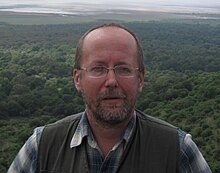A major contributor to this article appears to have a close connection with its subject. (March 2020) |
Andrey Korotayev | |
|---|---|
 Korotayev over the Rift Valley, North Tanzania, November 2008 | |
| Born | 17 February 1961 Moscow, Soviet Union |
| Nationality | Russian |
| Alma mater | Moscow State University |
| Known for | contributions to mathematical modelling of the World System development and cross-cultural studies |
| Awards | Russian Science Support Foundation Award in "The Best Economists of the Russian Academy of Sciences" nomination (2006)[1] In 2012 he was awarded with the Gold Kondratieff Medal[2] by the International N. D. Kondratieff Foundation. |
| Scientific career | |
| Fields | cross-cultural studies, mathematical modelling of social, economic, and historical dynamics; Islamic and pre-Islamic history |
| Institutions | HSE University (Moscow) Russian Academy of Sciences (Moscow) Institute for Advanced Study(Princeton) Russian State University for the Humanities (Moscow) |
Andrey Vitalievich Korotayev (Russian: Андре́й Вита́льевич Корота́ев; born 17 February 1961) is a Russian anthropologist, economic historian, comparative political scientist, demographer and sociologist, with major contributions to world-systems theory, cross-cultural studies, Near Eastern history, Big History, and mathematical modelling of social and economic macrodynamics.[3]
He is currently the Director of the Centre for Stability and Risk Analysis at the HSE University in Moscow,[4] and a Senior Research Professor at the Center for Big History and System Forecasting of the Institute of Oriental Studies[5][6] as well as in the Institute for African Studies of the Russian Academy of Sciences.[7]
In addition, he is a senior research professor of the International Laboratory on Political Demography and Social Macrodynamics (PDSM) of the Russian Presidential Academy of National Economy and Public Administration,[8] as well as a full professor of the Faculty of Global Studies of the Moscow State University.[9]
He is co-editor of the journals Social Evolution & History and Journal of Globalization Studies,[10] as well as History & Mathematics[11] yearbook[12]
Together with Askar Akayev and George Malinetsky he was in 2008-2018 a coordinator of the Russian Academy of Sciences Program "System Analysis and Mathematical Modeling of World Dynamics".[13]
- ^ "The Best Economists of the Russian Academy of Sciences". Russian Academy of Sciences. Archived from the original on 24 December 2018. Retrieved 27 June 2006.
- ^ "ИТОГИ VII МЕЖДУНАРОДНОГО КОНКУРСА НА СОИСКАНИЕ ЗОЛОТОЙ, СЕРЕБРЯНОЙ, БРОНЗОВОЙ МЕДАЛЕЙ И ПАМЯТНОЙ МЕДАЛИ ДЛЯ МОЛОДЫХ УЧЕНЫХ «За вклад в развитие общественных наук» от 28 апреля 2012 года". ИТОГИ VII МЕЖДУНАРОДНОГО КОНКУРСА НА СОИСКАНИЕ ЗОЛОТОЙ, СЕРЕБРЯНОЙ, БРОНЗОВОЙ МЕДАЛЕЙ И ПАМЯТНОЙ МЕДАЛИ ДЛЯ МОЛОДЫХ УЧЕНЫХ «За вклад в развитие общественных наук» от 28 апреля 2012 года. 30 September 2019. Archived from the original on 12 October 2013.
- ^ Global Studies Directory. ISBN 9789004348479. Leiden: Brill, 2018, pp. 182–183.
- ^ "HSE University - Moscow staff". hse.ru.
- ^ Институт Востоковедения Российской Академии Наук
- ^ Институт Востоковедения Российской Академии Наук
- ^ "Centre for Civilisational and Regional Studies | Institute for African Studies". inafran.ru.
- ^ RANEPA - First International Conference on Political Demography and Social Macro-Dynamics
- ^ "Андрей Витальевич Коротаев". Istina. Retrieved 31 December 2013.
- ^ "Journal of Globalization Studies". 2010. ISSN 2075-8103.
- ^ "History and mathematics: Historical Dynamics and Development of Complex Societies". URSS. Archived from the original on 22 July 2010. Retrieved 31 December 2013.
- ^ Almanac (together with Leonid Grinin and Arno Tausch).
- ^ Note that the analysis of log-linear oscillations in the gold price dynamics for 2003–2010 conducted by him together with Askar Akayev allowed them to forecast in November 2010 a possible start of the second wave of the global crisis in June – August 2011. See Askar Akayev, Alexey Fomin, Sergey Tsirel, and Andrey Korotayev. Log-Periodic Oscillation Analysis Forecasts the Burst of the "Gold Bubble" in April – June 2011. Structure and Dynamics 4/3 (2010): 1–11.